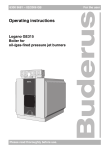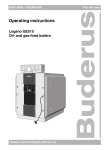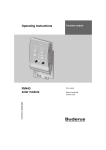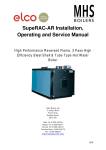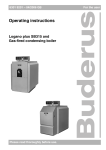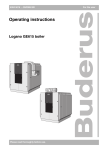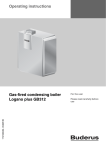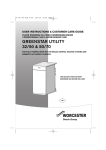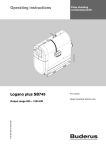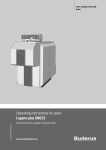Download Operating instructions
Transcript
6302 6959 – 02/2006 GB Operating instructions Logano G215 WS Oil and gas-fired boilers Please read thoroughly before use. For the user Overview Regulations and directives Installation: 90/396/EEC gas appliance directive 92/42/EEC boiler efficiency directive 73/23/EEC low voltage directive 89/336/EEC EMC directive 97/23/EC pressure equipment directive current Gas safety (Installation and Use) Regulations The Building Regulations Building Standards (Scotland) IEE Wiring Regulations BS 7671 National and ByLaws of the local water undertaking Corgi registered required to work on the appliance (Competent Persons) Oftec registered required to work on the appliance (Competent Persons) Codes of practice: BS 6880 BS 6644 Code of practice for low temperature hot water heating systems for output greater than 45kW Specification for Installation of gas-fired hot water boilers of rated inputs between 70kW (net) and 1.8 MW (net) (2nd and 3rd family gases) CP 342.2 centralised hot water supply BS 5449 Forced circulation hot water systems BS 5546 Installation of gas hot water supplies for domestic purpose (2nd. Family Gases) BS 6891 Low pressure installation pipes BS 5410 Code of practice for Oil firing Part 2 BS 5854 & IM/11 Codes of Pracitice for flues (as appropriate) BS 7074 Application Selection & Installation of Expansion vessels & ancillary for sealed water systems Part 2 IGE/UP/1 Soundness testing & purging of industrial & commercial installations IGE/UP/2 Gas installation pipework and compressors on industrial and commercial premises IGE/UP/7 Gas installations in Timber framed buildings IGE/UP/10 Installation of gas appliances in industrial and commercial premises, part 1: flued appliances CISBE Guide Management of Health and & Safety at work regulations 1992 - Guidance note PM5 Health & Safety at work act 1974 Manual Handling Regulations 1992 The Electricity at Work Regulations, 1989 We reserve the right to make any changes due to technical modifications. 2 Operating instructions Logano G115 WS oil/gas-fired special boilers • Issue 02/2006 Index 1 For your safety 1.1 1.2 1.3 1.4 . . . . . . . . . . . . . . . . . . . . . . . . . . . . . . . . . . . . . . . . . . . . . . .4 About this manual . . . . . . Correct use . . . . . . . . . . Key to symbols . . . . . . . . Please observe these notes . . . . . . . . . . . . . . . . . 2 Product description . 3 Operation of the heating system. 4 . . . . . . . . . . . . . . . . . . . . . . . . . . . . . . . . . . . . . . . . . . . . . . . . . . . . . . . . . . . . . . . . . . . . . . . . . . . . . . . . . . . . . . . . . . . . . . . . . . . . . . . . . . . . . . . . . . . . . . . . . . . . . . . . .4 .4 .4 .4 . . . . . . . . . . . . . . . . . . . . . . . . . . . . . . . . . . . . . . . . . . .5 . . . . . . . . . . . . . . . . . . . . . . . . . . . . . . . . . .6 3.1 3.2 3.3 3.4 Switching on the heating system . . . . . . . . . . . . . . . . . . . . . . . . . . . . . . . . . . Switching off the heating system . . . . . . . . . . . . . . . . . . . . . . . . . . . . . . . . . . Emergency measures . . . . . . . . . . . . . . . . . . . . . . . . . . . . . . . . . . . . . . . . Check the operating pressure, if necessary top up with heating water and vent the system . 3.5 3.6 3.4.1 When should you check the operating pressure? . 3.4.2 Operating pressure, checking . . . . . . . . . . . 3.4.3 Filling the heating system and checking for leaks . 3.4.4Filling the heating system . . . . . . . . . . . . . . . Operating tips . . . . . . . . . . . . . . . . . . . . . . . Why is regular maintenance important? . . . . . . . . Trouble shooting . . . . . . . . . . . . . . . . . . . . . . . . . . . . . . . . . . . . . . . . . . . . . . . . . . . . . . . . . . . . . . . . . . . . . . . . . . . . . . . . . . . . . . . . . . . . . . . . . . . . . . . . . . . . . . . . . . . . . . . . . . . . . . . . . . . . . . . . . . . . . . . . . . . .6 .6 .6 .7 .7 .7 .7 .8 .9 .9 . . . . . . . . . . . . . . . . . . . . . . . . . . . . . . . . . . . . . . . . . . . . 10 We reserve the right to make any changes due to technical modifications. Operating instructions Logano G215 WS oil/gas-fired special boilers • Issue 02/2006 3 1 For your safety 1 For your safety 1.1 About this manual RISK TO LIFE These installation and maintenance instructions contain important information for the safe and correct installation, initial start-up and maintenance of this boiler. by unqualified personnel. WARNING! In the following text, the Logano G215 WS oil and gasfired boilers will generally be described as „the boiler“. 1.2 Correct use The boiler is designed for generating heating water and domestic hot water (DHW) when used with hot water cylinder, for example, in detached homes or in apartment buildings or smaller commercial properties. 1.3 z Installation, commissioning and maintenance must only be carried out by a specialist installer. Work on electrical and fuel-bearing components in particular must only be carried out by suitably qualified personnel. 1.4.1 If you notice a smell of gas RISK TO LIFE through the explosion of volatile gases. There is a risk of explosion if you can smell WARNING! gas. Key to symbols z Keep naked flames away. Do not smoke. Do not use lighters. In these instructions, the following symbols are used: z Avoid sparks! Do not operate electrical switches, including telephones, plugs or doorbells. RISK TO LIFE Identifies possible risks which may lead to serious injury or death if appropriate care is WARNING! not taken. z Close the main gas shut-off valve. z Open windows and doors. CAUTION! RISK OF INJURY/ SYSTEM DAMAGE z Warn all occupants, but do not use doorbells. Identifies potentially dangerous situations which might lead to medium or slight injuries or to material losses. z Leave the building. PLEASE NOTE z If necessary, notify police or fire brigade! z Call your gas supplier and your local heating engineer from outside the building. User tip for the optimum utilisation and setting of the control(s) plus useful information. Î Cross-references z Immediately leave the danger zone if you hear gas escaping. 1.4.2 Tips regarding the installation room Cross-references to a specific point or another document are identified by an arrow Î. 1.4 Please observe these notes RISK TO LIFE through poisoning. Insufficient ventilation can lead to WARNING! dangerous flue gas leaks. z Never close or obstruct air ducts and vent apertures or reduce their size. You will learn how to use your heating system by – letting your installer instruct you when the system is handed over and – reading these operating instructions carefully. z The boiler must not be operated, until the obstruction has been removed. Do not carry out any work on the boiler that is not described in these operating instructions. RISK OF FIRE through flammable material or liquids. WARNING! z Never store flammable materials or liquids in the immediate vicinity of the boiler. We reserve the right to make any changes due to technical modifications. 4 Operating instructions Logano G215 WS oil/gas-fired special boilers • Issue 02/2006 Product description 2 2 Product description This boiler is a low temperature boiler for oil or gas combustion with modulating boiler water temperature control. 1 Your specialist heating company has equipped the boiler with a suitable burner. The boiler comprises: 2 – Control device – Boiler casing 3 – Boiler block with thermal insulation The control device monitors and controls all electrical boiler components. The boiler casing prevents energy losses and acts as sound insulation. The boiler block transfers the heat generated by the burner to the heating water. The thermal insulation prevents energy losses. This product meets all basic requirements of relevant standards and directives. 4 Fig. 1 1 2 3 4 Boiler without burner Control device Boiler casing Boiler block with thermal insulation Burner door casing We reserve the right to make any changes due to technical modifications. Operating instructions Logano G215 WS oil/gas-fired special boilers • Issue 02/2006 5 3 Operation of the heating system 3 Operation of the heating system 3.1 Switching on the heating system Before switching the system on, check – that the operating pressure is high enough, – that the fuel supply at the main shut-off valve is open and – that the heating system emergency stop switch is switched on. z Switch the boiler water thermostat to "AUT" (Automatic). z Switch the ON/OFF switch to ON (position "I"). This switches on the entire heating system. PLEASE NOTE Operating instructions, e. g. how to set the temperature, can be found in the Î control unit documentation. 3.2 I 0 2 1 Switching off the heating system z Switch the ON/OFF switch on the control to OFF (position "0"). This switches the boiler and all its components OFF (for example the burner). z Close the main fuel shut-off valve. Fig. 2 1 2 Switching on the heating system (Logamatic 2000) Set the boiler water thermostat ON/OFF switch SYSTEM DAMAGE through frost. CAUTION! The heating system can freeze up, if it has been shut down. z Leave the heating system switched ON as long as possible. z Protect your heating system against freezing by draining the heating system and DHW pipework at the lowest possible point. 1 Fig. 3 1 2 3.3 2 Switching on the heating system (Logamatic 4000) Set the boiler thermostat ON/OFF switch Emergency measures In the event of an emergency, e. g. a fire, proceed as follows: z Close the main fuel shut-off valve. z Isolate the heating system from the mains power supply via the heating system emergency stop switch or a corresponding domestic fuse. We reserve the right to make any changes due to technical modifications. 6 Operating instructions Logano G215 WS oil/gas-fired special boilers • Issue 02/2006 Operation of the heating system 3.4 3 Check the operating pressure, if necessary top up with heating water and vent the system 3.4.1 When should you check the operating pressure? Recently topped-up heating water loses much of its volume in the first few days because it releases gases. This causes air pockets, and the heating system will start to rumble. z After installing a new heating system, check the operating pressure daily for the first few days. If necessary top up with heating water and bleed the radiators. z After a while the operating pressure will only need to be checked monthly. If necessary top up with heating water and bleed the radiators. 3.4.2 Operating pressure, checking The installer will have set the red needle on the pressure gauge to the required operating pressure (at least 1 bar pressure). 2 z Check that the pressure gauge needle is within the green range. 1 z Top up with heating water if the pressure gauge needle is below the green range. 3.4.3 Filling the heating system and checking for leaks 3 Before commissioning the heating system, check for leaks to prevent problems during operation. Pressurise the heating system to 1.3x permissible operating pressure (observe the safety pressure of the safety valve). SYSTEM DAMAGE CAUTION! over pressure during leak testing. Pressure, control and safety equipment may be damaged through excessive pressure. Fig. 4 1 2 3 Pressure gauge for sealed systems Red needle Pressure gauge needle Green marking z When you carry out a leak test, make sure that no pressure, control or safety equipment is fitted which cannot be isolated from the boiler water chamber. z Shut off the pressure expansion vessel from the system by closing the cap valve. z Check the connections and pipework for leaks. z Opening the mixing and shut-off valves on the hot water (primary) side. z Fill the system via an approved filling link. We reserve the right to make any changes due to technical modifications. Operating instructions Logano G215 WS oil/gas-fired special boilers • Issue 02/2006 7 3 Operation of the heating system 3.4.4 Filling the heating system Filling and refilling of the heating circuit must been carried out by a method that has been approved by the Water Regulation Advisory Scheme (WRAS), for the type of heating appliances, i.e. Domestic (in-house) Fluid Category 3. Non-Domestic (other than in-house) Fluid Category 4. Depending on the Fluid Category the approved method should comprise of the following: 1. Requirements Fluid Category 3 systems (fig see below) z Control valve (stop valve) including a double check valve on the mains cold water supply pipe z Temporary connection to e removed after filling (filling loop) z Control valve (stop valve) on the heating system pipework Fig. 5 Requirements Fluid Category 3 systems Fig. 6 Requirements Fluid Category 4 systems 2. Requirements Fluid Category 4 systems (fig see below) z Control valve (stop valve) on the mains cold water supply pipe z Strainer z Verifiable Backflow Prevention Device with reduced pressure Zone(RPZ valve assembly) incorporating a Type BA air gap z Tundish z Control valve (stop valve) on the heating system pipework z Shut off the pressure expansion vessel from the system by closing the cap valve. z Slowly fill the heating system. Observe the pressure gauge whilst filling. z Close the water tap and the boiler fill & drain valve once the required operating pressure has been reached. We reserve the right to make any changes due to technical modifications. 8 Operating instructions Logano G215 WS oil/gas-fired special boilers • Issue 02/2006 Operation of the heating system 3.5 3 Operating tips Correct fuel This heating system requires fuel of the correct type and grade to ensure its proper operation. Use the following fuel only: SYSTEM DAMAGE through incorrect fuel. CAUTION! z Only use the fuel specified. Follow the advice of your installer if you want to convert your heating system to another type of fuel or use fuel with a different specification. Company stamp/date/signature Location BOILER DAMAGE CAUTION! through contaminated drawn into the boiler air. z Never use chlorinated cleaning agents or halogenated hydrocarbons (as, for example, contained in spray cans, solvents or cleaning agents, paints and adhesives). z Avoid very dusty atmospheres. 3.6 Why is regular maintenance important? Heating systems should be regularly maintained for the following reasons: – to achieve a high level of efficiency and to operate the system economically (low fuel consumption), – to achieve a high level of operational reliability, – to maintain the highest level of environmentally responsible combustion. SYSTEM DAMAGE CAUTION! through a lack of, or unsatisfactory, cleaning and maintenance. z Have your system inspected, cleaned and maintained annually by your installer or a service engineer. z We recommend you enter into a contract covering an annual inspection, and maintenance as required. We reserve the right to make any changes due to technical modifications. Operating instructions Logano G215 WS oil/gas-fired special boilers • Issue 02/2006 9 4 4 Trouble shooting Trouble shooting We differentiate between two types of faults – Burner faults and – Control unit and heating system faults. A fault lamp on the burner illuminates if the burner develops a fault. Generally, such faults can be reset by pressing the reset button on the burner. Control device and heating system faults are indicated on the control device display, subject to the control device being equipped with a display. For further information see Î control device documentation. Correcting burner faults z Press the burner reset button (Î burner documentation). CAUTION! 1 SYSTEM DAMAGE Fig. 7 through frost. 1 Resetting the burner Burner The heating system can freeze up, if it has been switched OFF through a fault shutdown. z Try to remedy the fault. z Contact your installer immediately if this is not possible. We reserve the right to make any changes due to technical modifications. 10 Operating instructions Logano G215 WS oil/gas-fired special boilers • Issue 02/2006 Notes We reserve the right to make any changes due to technical modifications. Operating instructions Logano G215 WS oil/gas-fired special boilers • Issue 02/2006 11 Your installer: . Buderus Cotswold Way, Warndon, Worcester WR4 9SW Tel.: 01905 752794, Fax: 01905 753130 www.buderus-commercial.co.uk In the UK, Buderus is a trading name of BBT Thermotechnology Ltd. BBT Thermotechnik GmbH D-35573 Wetzlar www.heiztechnik.buderus.de [email protected]












